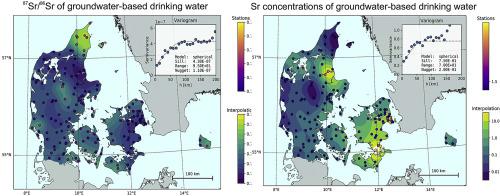当前位置:
X-MOL 学术
›
Appl. Geochem.
›
论文详情
Our official English website, www.x-mol.net, welcomes your
feedback! (Note: you will need to create a separate account there.)
The link between surface water and groundwater-based drinking water – strontium isotope spatial distribution patterns and their relationships to Danish sediments
Applied Geochemistry ( IF 3.1 ) Pub Date : 2020-10-01 , DOI: 10.1016/j.apgeochem.2020.104698 Robert Frei , Karin M. Frei , Søren Munch Kristiansen , Søren Jessen , Jörg Schullehner , Birgitte Hansen
Applied Geochemistry ( IF 3.1 ) Pub Date : 2020-10-01 , DOI: 10.1016/j.apgeochem.2020.104698 Robert Frei , Karin M. Frei , Søren Munch Kristiansen , Søren Jessen , Jörg Schullehner , Birgitte Hansen

|
Abstract The hydrological relationship between surface waters and groundwaters in many regions of the world is well known and the effects of their mutual interaction and interaction with the soils and bedrocks, with respect to resulting changes in their chemical composition, are well studied. In this study we add to this knowledge by comparing the distributional patterns of strontium (Sr) isotopes in previously published 192 surface water samples with those of newly acquainted Sr isotope data from groundwater-based drinking water samples extracted from 163 of the major waterworks in Denmark. The aim is to investigate potential compositional changes that might derive from the interaction with the aquifer lithology or overlying sediments and soils. The average Sr isotope signatures of surface and groundwater-based drinking waters define 87Sr/86Sr values of 0.7096 ± 0.0015 (2σ) and 0.7088 ± 0.0013 (2σ), respectively. The skewed distribution of Sr isotope compositions in groundwaters towards lower 87Sr/86Sr values indicates enhanced contribution of natural carbonate-derived strontium with depth, while slightly elevated 87Sr/86Sr signatures in surface waters may reflect the diminished contribution of Sr from carbonates in the glaciogenic sediments due to their progressive acid dissolution. Strontium concentrations [Sr] in groundwater-based drinking water from the participating major waterworks define a country-wide average of 1.17 mg/L and the distributional pattern shows an East – West decreasing trend. Lowest concentrations are found in the West Jutland glaciogenic province (WJGP; average [Sr] = 0.36 mg/L) and in the northernmost tip of Jutland. A corresponding pattern, although less pronounced, is also depicted by the 87Sr/86Sr signatures of groundwater-based drinking water, whereby increasing 87Sr/86Sr values from Zealand through Funen into the Jutland peninsula correspond with increasing thickness of glaciogenic overburden providing (though mass-balance wise subordinate) radiogenic Sr to the natural carbonate-dominated groundwaters. The highest 87Sr/86Sr values are recorded in waters from northern Jutland, possibly reflecting the admixture of radiogenic strontium from late glacial and post-glacial glacio-isostatic adjustment-related marine aquifers. Generally, the surprisingly rather homogeneous and similar distributional patterns of 87Sr/86Sr signatures of Danish aquifers and surface waters implies a strong and dominant control of Sr by natural clastic (reworked) carbonate components in the Quaternary, Miocene and Holocene sediments, and to lesser degree (with the exception of northern central Jutland and Eastern Zealand) from the pre-Quaternary limestone dominated “basement” directly. Our results are consistent with a tight hydrological and geochemical interrelationship between surface waters and groundwaters in Denmark. There is a need for further investigations of the effects of advanced treatment of soft (acidic) groundwater-based drinking water on the concentrations and isotopic signatures of trace elements such as Sr. However, our study lends support for the adequate use of Sr isotope signatures of either of these waters to characterize the isotope compositional range of bioavailable fractions relevant for authenticity identification, forensic studies, and for prehistoric and modern human and animal proveniencing.
中文翻译:

地表水和地下水饮用水之间的联系——锶同位素空间分布模式及其与丹麦沉积物的关系
摘要 世界许多地区地表水和地下水之间的水文关系是众所周知的,它们与土壤和基岩的相互作用和相互作用对其化学成分的影响也得到了很好的研究。在这项研究中,我们通过比较先前发表的 192 个地表水样品中锶 (Sr) 同位素的分布模式与从丹麦 163 个主要水厂中提取的地下水饮用水样品中新认识的 Sr 同位素数据的分布模式来增加这一知识. 目的是调查可能源于与含水层岩性或上覆沉积物和土壤相互作用的潜在成分变化。地表水和地下水基饮用水的平均 Sr 同位素特征定义 87Sr/86Sr 值分别为 0.7096 ± 0.0015 (2σ) 和 0.7088 ± 0.0013 (2σ)。地下水中 Sr 同位素组成向较低 87Sr/86Sr 值的偏斜分布表明,天然碳酸盐衍生的锶随深度的贡献增强,而地表水中 87Sr/86Sr 特征略有升高可能反映了冰川沉积物中碳酸盐 Sr 的贡献减弱由于它们逐渐酸溶解。参与的主要水厂地下水中的锶浓度 [Sr] 的全国平均值为 1.17 mg/L,分布格局呈东-西下降趋势。在西日德兰冰川产区(WJGP;平均 [Sr] = 0.36 mg/L) 和在日德兰半岛的最北端。一个相应的模式,虽然不太明显,但也由地下水基饮用水的 87Sr/86Sr 特征描述,其中从西兰岛到菲英岛到日德兰半岛的 87Sr/86Sr 值增加对应于冰川形成覆盖层的厚度增加(尽管质量-平衡明智的从属)放射性 Sr 到天然碳酸盐为主的地下水。最高的 87Sr/86Sr 值记录在日德兰半岛北部的水域中,这可能反映了来自晚冰期和后冰期冰川均衡调整相关海洋含水层的放射性锶的混合物。一般来说,丹麦含水层和地表水的 87Sr/86Sr 特征令人惊讶的相当均匀和相似的分布模式表明,第四纪、中新世和全新世沉积物中的天然碎屑(再加工)碳酸盐组分对 Sr 有强烈和主导的控制,并在较小程度上(与除了日德兰半岛中北部和新西兰东部之外)来自第四纪前石灰岩的直接主导“基底”。我们的结果与丹麦地表水和地下水之间紧密的水文和地球化学相互关系一致。需要进一步研究软(酸性)地下水基饮用水的深度处理对 Sr 等微量元素的浓度和同位素特征的影响。 然而,
更新日期:2020-10-01
中文翻译:

地表水和地下水饮用水之间的联系——锶同位素空间分布模式及其与丹麦沉积物的关系
摘要 世界许多地区地表水和地下水之间的水文关系是众所周知的,它们与土壤和基岩的相互作用和相互作用对其化学成分的影响也得到了很好的研究。在这项研究中,我们通过比较先前发表的 192 个地表水样品中锶 (Sr) 同位素的分布模式与从丹麦 163 个主要水厂中提取的地下水饮用水样品中新认识的 Sr 同位素数据的分布模式来增加这一知识. 目的是调查可能源于与含水层岩性或上覆沉积物和土壤相互作用的潜在成分变化。地表水和地下水基饮用水的平均 Sr 同位素特征定义 87Sr/86Sr 值分别为 0.7096 ± 0.0015 (2σ) 和 0.7088 ± 0.0013 (2σ)。地下水中 Sr 同位素组成向较低 87Sr/86Sr 值的偏斜分布表明,天然碳酸盐衍生的锶随深度的贡献增强,而地表水中 87Sr/86Sr 特征略有升高可能反映了冰川沉积物中碳酸盐 Sr 的贡献减弱由于它们逐渐酸溶解。参与的主要水厂地下水中的锶浓度 [Sr] 的全国平均值为 1.17 mg/L,分布格局呈东-西下降趋势。在西日德兰冰川产区(WJGP;平均 [Sr] = 0.36 mg/L) 和在日德兰半岛的最北端。一个相应的模式,虽然不太明显,但也由地下水基饮用水的 87Sr/86Sr 特征描述,其中从西兰岛到菲英岛到日德兰半岛的 87Sr/86Sr 值增加对应于冰川形成覆盖层的厚度增加(尽管质量-平衡明智的从属)放射性 Sr 到天然碳酸盐为主的地下水。最高的 87Sr/86Sr 值记录在日德兰半岛北部的水域中,这可能反映了来自晚冰期和后冰期冰川均衡调整相关海洋含水层的放射性锶的混合物。一般来说,丹麦含水层和地表水的 87Sr/86Sr 特征令人惊讶的相当均匀和相似的分布模式表明,第四纪、中新世和全新世沉积物中的天然碎屑(再加工)碳酸盐组分对 Sr 有强烈和主导的控制,并在较小程度上(与除了日德兰半岛中北部和新西兰东部之外)来自第四纪前石灰岩的直接主导“基底”。我们的结果与丹麦地表水和地下水之间紧密的水文和地球化学相互关系一致。需要进一步研究软(酸性)地下水基饮用水的深度处理对 Sr 等微量元素的浓度和同位素特征的影响。 然而,











































 京公网安备 11010802027423号
京公网安备 11010802027423号